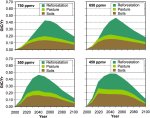Atmospher Sci & Global Chg
Research Highlights
September 2008
Using Mother Nature to Reduce Greenhouse Gases
 Using a model known as MiniCam, the Pacific Northwest National Laboratory team explored the potential contribution of terrestrial sequestration toward meeting the goals of four different climate policies—government regulations that set limits on greenhouse gas emissions.
Using a model known as MiniCam, the Pacific Northwest National Laboratory team explored the potential contribution of terrestrial sequestration toward meeting the goals of four different climate policies—government regulations that set limits on greenhouse gas emissions.GtC = gigatons of carbon
Ppmv = parts per million by volume Enlarged View
Results: New research suggests that adopting low-cost land management practices that naturally sequester carbon dioxide could contribute up to 20% of the carbon mitigation needed worldwide in the first half of this century.
For the first time, scientists included terrestrial sequestration options in computer simulations of the cost and technology options necessary to stabilize greenhouse gas concentrations in the atmosphere by 2100. Under various land management scenarios in this century, global terrestrial sequestration could keep between 84 and 150 gigatons of carbon dioxide from entering the atmosphere. Land management changes included reducing tillage on crop land, changing grassland grazing patterns, and converting land to forests.
The scenarios illustrate that carbon mitigation is a multi-technology, multi-sector challenge for which there is no single solution. Many different options must contribute to emissions mitigation, and each one lowers the overall cost of mitigation. Terrestrial sequestration is one of these options.
Why it Matters: Carbon dioxide is a greenhouse gas and a major contributor to climate change due to enhanced emissions produced by combustion of fossil fuels and land use change. In undisturbed terrestrial ecosystems, there is usually a balance between the carbon dioxide that gets exchanged via photosynthesis and respiration, a process in which plants release carbon dioxide. However, when deforestation, overgrazing, or poor soil management practices occur, the balance is upset, resulting in an excess release of carbon dioxide back to the atmosphere. Reforestation and applying improved grazing and soil management practices, such as no till, have the capacity to recover some of this carbon lost to the atmosphere and retain it as organic matter in vegetation and soils. To be effective, however, terrestrial carbon sequestration needs to occur on a global scale. By valuing the carbon in terrestrial ecosystems and adopting land management practices that sequester carbon, terrestrial carbon sequestration can be a low-cost option for climate change mitigation.
Methods: Scientists developed models to estimate the potential for terrestrial carbon sequestration in agricultural soils, reforestation, and pasturelands based on ecological and geographic information. These estimates were then used in MiniCAM, a computer model developed by Pacific Northwest National Laboratory scientists. MiniCAM is an integrated assessment model that projects greenhouse gas emissions under various climate change policies and mitigation technologies. The resulting data showed cost and technology options for stabilizing atmospheric greenhouse gas concentrations.
What's Next: The methods described here provide a foundation, which will be improved on and more fully integrated into future MiniCAM scenario analyses.
Acknowledgments: PNNL advances scientific frontiers for U.S. competitiveness by transforming the nation's ability to predict climate change and its impacts. The research team is from the Joint Global Change Research Institute, a partnership of the Pacific Northwest National Laboratory and the University of Maryland. This research was performed under the U.S. Climate Change Technology Program, building on research supported by DOE's Office of Science, Integrated Assessment Research Program, Climate Change Research Division; and NASA.
Reference: Thomson, A.M., R.C. Izaurralde, S.J. Smith, and L.E. Clarke. 2007. "Integrated estimates of global terrestrial carbon sequestration." Global Environmental Change, 18:1, 192-203.
